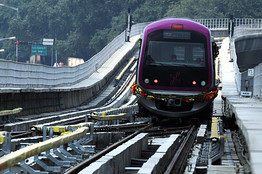
Image: Dibyangshu Sarkar/Agence France-Presse/Getty Images Despite Bangalore’s recognition as a city of opportunities, 25% of the city’s population lives in “official” slums and the rising cost of living there is making it harder. Shown, the Bangalore Metro.
Debalina Ghosh, 23, moved to Mumbai four months ago, cursing Bangalore’s high cost of living. “There is just nothing that I could save,” the PR professional says, casting her mind back to expensive auto rides within the city and the high cost of rent.
Figures from the Reserve Bank of India on the consumer price index for industrial workers show that Bangalore sits higher than other tier-one cities like Mumbai, Delhi and Chennai. The CPI, calculated with 2001 as the base year, measures a standard basket of essential commodities like food, clothing, transport, electricity and education.
Kartik Ganapathy, a partner at IndusLaw, says costs are being driven up by the growing consumer class in the city, while a Legatum Institute-funded study on Bangalore by Edward Glaeser of Harvard University adds: “Real incomes grew by 73% between 1998 and 2005. This growth was much faster than the growth of India as a whole… Today [2010], Bangalore incomes are nearly seventy percent higher than the Indian average.”
“The rise of Bangalore as a software center has certainly created large financial benefits for many Indians. The city is now home to 10,000 millionaires and per capita income in the urban agglomeration is twice that of the Indian average,” Mr. Glaeser says.
Manohar Shastri, a 43-year-old who works in the software industry, says he was paid 5,000 rupees ($95) a month when he started work in Bangalore in the early 1990s. Nowadays he lives in a two-storey house in the semi-posh locality of south Bangalore and can afford to send his only son to one of the city’s most expensive schools, but he feels the pinch: “For a family of three watching a movie over the weekend would mean an expenditure of more than a thousand rupees… we just can’t afford it all the time.”
“Since Bangalore has the highest paid professionals, the price of traded goods and local services go up,” says Jayati Ghosh, an economics professor at Delhi’s Jawaharlal Nehru University, “this affects the poor more adversely.”
Citing a report by the Indian Institute of Science, Mr. Glaeser’s study adds that about 25% of Bangalore’s population lives in “official” slums.
After a one kilometer hike in the hot April sun, Mary Rani reaches her 10-feet wide tin hut, carrying her monthly groceries – 16 kilograms of rice and 3kg of sugar. “I just paid 250 rupees for it,” the 27-year-old grumbles. She holds a BPL (Below Poverty Line) card that enables her to buy grains and sugar at a lower cost from government Fair Price Shops.
“I can’t afford to buy rice from anywhere else as it would cost me 35-40 rupees per kg,” she says. Her family’s monthly income is 6,000 rupees ($115), of which 700 rupees goes to rent for the shack where she lives with her husband and four sons. Mary’s husband, Anthony, is a construction worker.
“The city is almost uninhabitable for the poor,” says Bhawani, a community worker in the slums of Valmiki Nagar in west Bangalore. “Costs of essentials like vegetables and LPG [liquefied petroleum gas] cylinders have reached the sky.” In Bangalore, it costs 415 rupees for a 14.2 kg LPG cylinder, compared with 402 rupees in Mumbai and a heavily subsidized 399 rupees in New Delhi.
Rising costs in Bangalore could also have an adverse impact on the ability of the “Garden City” to attract businesses. Shiela Britto came to Bangalore from Mumbai in 2003 to set up a consultancy firm that deals with, among other things, infrastructure and solar energy. Her office is located on the posh MG Road and she considers herself to be in the high income group, but she bemoans the surge in real estate prices and labor costs since her arrival.
Today, entrepreneurs like Ms. Britto might think twice about setting up shop in Bangalore, even though city is still known for its start-up culture.
“Start-ups in Bangalore mean largely IT sector start-ups even today,” says Mr. Ganapathy of IndusLaw. But because of the rising costs in the city, “such enthusiasm might not last long,” he adds.
Published in: The Wall Street Journal
Published on: 26 April, 2012
Link: https://blogs.wsj.com/indiarealtime/2012/04/26/bangalore-journal-living-in-indias-costliest-city/

